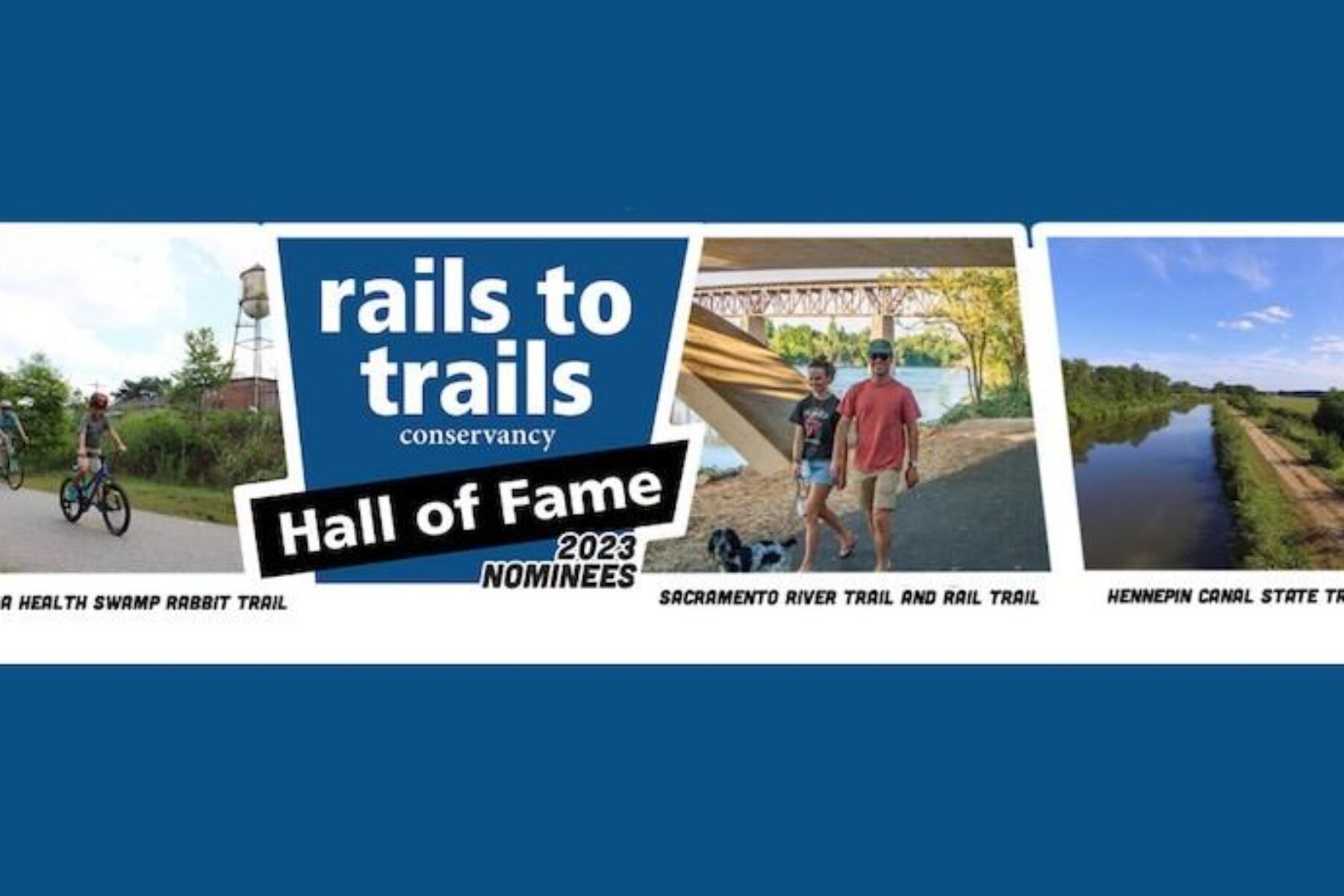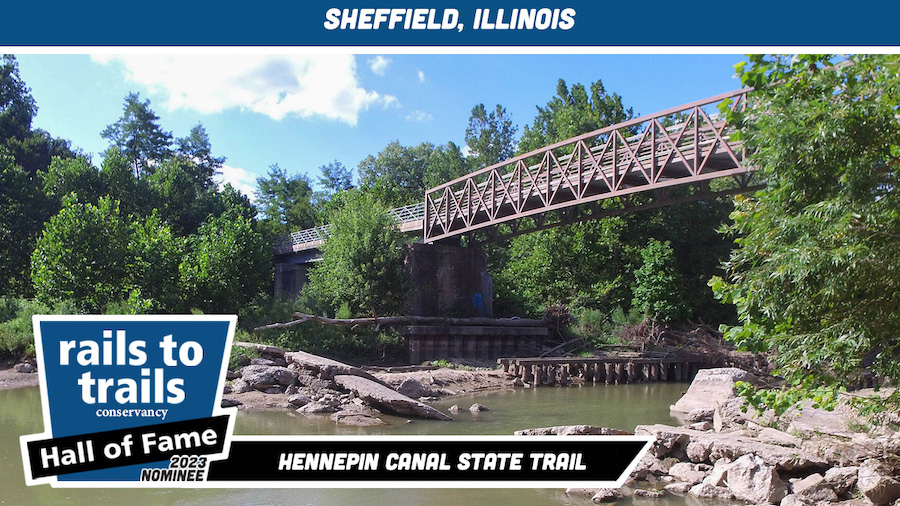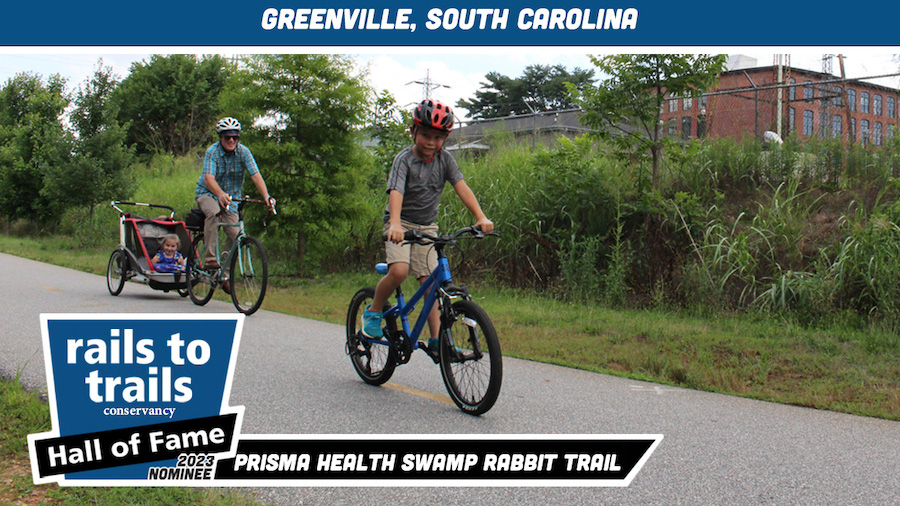Meet the 2023 Hall of Fame Nominees

Every year, America’s more than 40,000 miles of multiuse trails are used by millions of people in their day-to-day lives.
Since 2020, there has been unprecedented demand for trails—and the opportunity to connect those trails to each other and to the places we all want to go. In this moment, decades of advocacy are coming to fruition as more and more people are able to access trails in the places they live and in the places they want to visit.
Much of this momentum has been—and continues to be—inspired by exceptional trails that consistently deliver outstanding experiences for their users as well as numerous benefits to the community, environment and economy. These trails have helped pave the way and set a gold standard for new trail projects, which is why we believe that they should be recognized for their contributions to the movement and for just how truly awesome they are to use!
To honor these model trails, we established the Hall of Fame and have inducted more than 35 rail-trails since 2007. Today, as rail-trails, greenways, towpaths and other trails create space for striding and riding, connecting and relaxing, our team is expanding the Hall of Fame to include the breadth of multiuse trails that are fundamental to our vision of a future where trails connect everyone, everywhere. Beginning this year, the eligibility criteria of our Hall of Fame will now include all types of multiuse trails, with an emphasis on those that deliver the accessibility and trail use experience to be expected by a rail-trail and priority given to trails that contribute to the connectivity of regional trail and active transportation systems.
But with tons of superb trails out there, we need a little help picking which trail should take the title for 2023. We’ve narrowed the list down to three stellar nominees, all of which create more regional walking and biking connectivity and were selected based on merits such as scenic value, high use, trail and trailside amenities, accessibility, historical significance, excellence in management and maintenance of facility, community connections and geographic distribution.
We’re relying on you to help us choose just ONE of these trails to join the Hall of Fame. Get to know the nominees now, then prepare to support your top choice when online voting kicks off on July 31!
AUG. 10, 2023 UPDATE
Rails-to-Trails Conservancy (RTC), the nation’s largest trails advocacy organization, announced that California’s Sacramento River Rail Trail and Sacramento River Trail will be inducted to its iconic Hall of Fame. Learn more.

Hennepin Canal State Trail, Illinois
Coming in at an impressive 104.5 miles, the Hennepin Canal State Trail connects five counties in northwestern Illinois. True to its name, this linear park traces the route of the Hennepin Canal, which is listed on the National Register of Historic Places. The canal was conceptualized in the 1800s as an answer to bridge the divide between the Mississippi and Illinois rivers; it became the first canal in America built of concrete without stone cut facings and began hosting boat travel in 1907. Fast forward to modern times and you can still find boats along the canal as well as more than 30 locks, six of the original nine aqueducts, numerous bridges and other reminders of its past. In addition to its history, the estimated 1.3 million visitors per year can enjoy hiking, biking, fishing, hunting, horseback riding, camping, ice skating, snowmobiling, cross-country skiing and events planned by local groups—including the Hennepin Hundred, a 100-mile ultramarathon.
Fun Fact: The Hennepin Canal State Trail connects to several other trails and trail networks, allowing visitors ways to reach more destinations and stretch their adventures on this already long-distance pathway. Some of its connections include serving as the state’s gateway trail for the 3,700-mile cross-country Great American Rail-Trail®, the 500-miles-plus Grand Illinois Trail loop and the American Discovery Trail.

Prisma Health Swamp Rabbit Trail Network, South Carolina
The early vision for Greenville County’s Prisma Health Swamp Rabbit Trail (Swamp Rabbit) was to create a simple 9-mile rail-trail between the towns of Greenville and Travelers Rest. From that simple vision, an extraordinary 28-mile (and growing) network of trails now connects communities in the towns of Fountain Inn, Greenville, Simpsonville, Travelers Rest and beyond. After hopping into the minds of the community in the late 1990s, the first section of the trail opened in 2009 and, within five years, its usage—501,000 annual users—exceeded the total population of the county. Key to the Swamp Rabbit’s growth and success were Upstate Forever, Furman University, who helped acquire the railbed, and Prisma Health, a local healthcare provider, all of whom partnered with Greenville County to expand the trail into a network that provides opportunities to be active and get around by foot, bike and mobility devices. Different segments of the Swamp Rabbit Trail network feature picturesque views of the Blue Ridge Mountains, as well as pass near waterfalls and the idyllic Furman University along the Green Line segment; the Textile Crescent, an area named after the crescent shape formed by historic mills that were built during the textile boom and are now becoming live-work-play destinations, along the Orange Line segment; and the 400-plus acre Conestee Nature Preserve, which is a sanctuary for more than 220 bird species, along the Blue Line segment.
Fun Fact: Several businesses near the trail have experienced a monetary bump, with sales reportedly jumping up 10-85%, helping to contribute to the $6.7 million annual economic impact the Swamp Rabbit Trail delivers to the county.
Sacramento River Rail Trail and Sacramento River Trail, California
Nestled beneath the Cascade and Trinity mountains, the fittingly named Sacramento River Rail Trail and Sacramento River Trail meander along the largest river in California. The connected pair provides 21 miles of transportation and recreation trails that are steeped in nature. For centuries, the trail pair has served as a travel and trade route, first by Indigenous Peoples, then later by a subsidiary of the Central Pacific Railroad, and now by bicyclists and pedestrians in and around the City of Redding. Today, the trails work in tandem to connect neighborhoods, cultural and commercial districts, businesses, parks and other destinations. Additionally, the trails provide a way to access both the Shasta Lake Recreation Area and the Whiskeytown National Recreation Area. The trails also hold a bright future, serving as the backbone of a developing regional trail system that encompasses more than 250 miles of paved and dirt trails. Eventually, the trails will stretch from the Shasta Dam to Redding’s southern neighbor, Anderson, and beyond. This vast regional system of trails is a product of partnership: managed by the City of Redding, the National Park Service and the Bureau of Land Management with the support of local groups, foundations, other agencies and community members.
Fun Fact: Punctuated with an impressive rail tunnel and multiple bridges, one of the trail pair’s most awe-inspiring features is the Sundial Bridge, a 700-foot-long, cable-stayed, glass and steel working sundial spanning the Sacramento River, which attracts an estimated 100,000 annual visitors from around the world!

Donate
Everyone deserves access to safe ways to walk, bike, and be active outdoors.